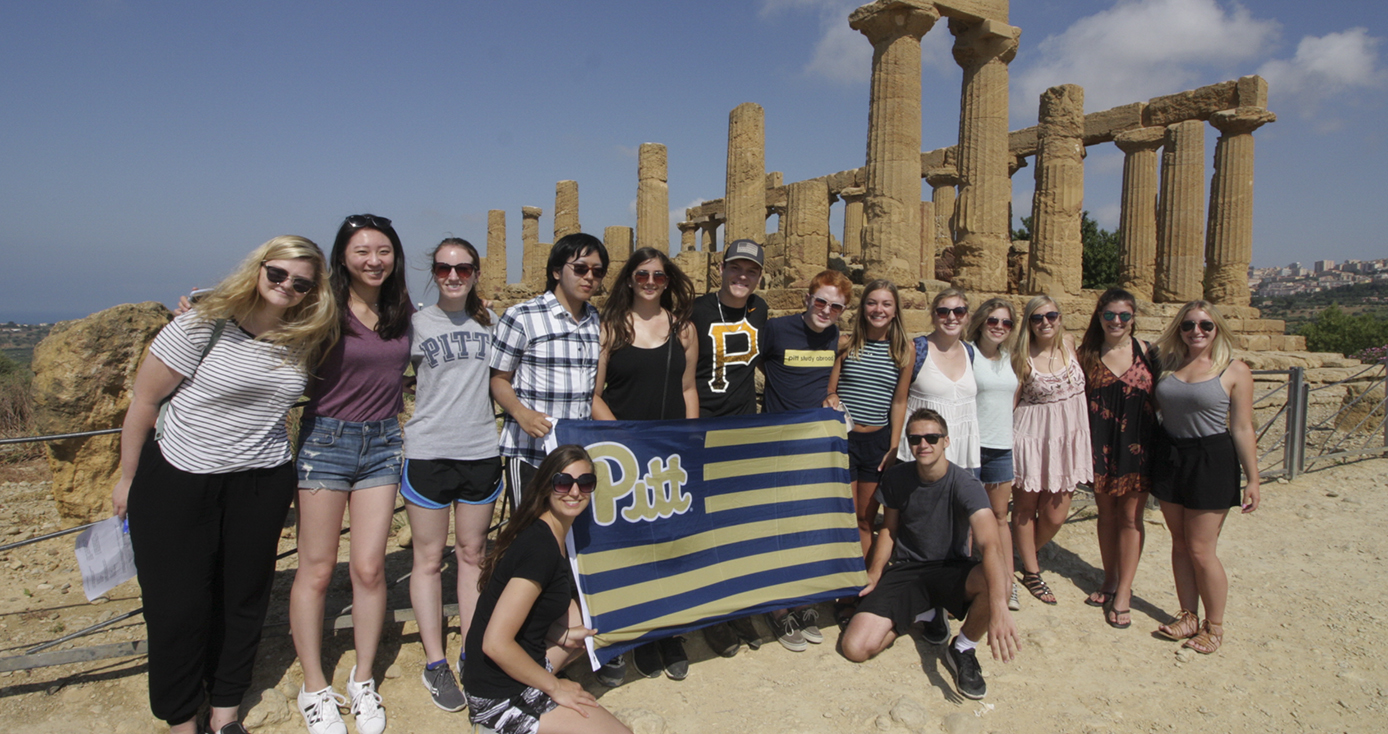
Subscribe to Pittwire Today
Get the most interesting and important stories from the University of Pittsburgh.Teaching Center Helps Students in Sicily Create 360-degree Tours of Archaeological Sites
To experience the full 360 degrees of the sites seen here, hit play, touch or click the video, then drag in the direction you want to look.
Standing among the ruins of the Roman Amphitheater of Siracusa in Sicily — an island just south of Italy — Pitt senior Jonathan Dyer gives a tour of what was once one of the area’s largest gladiator arenas. He points out the warrior’s main entrance at the southern end, a pit for holding beasts and machinery in the center, the main road leading into the theater hidden by brush just beyond Dyer’s left shoulder.
The tour is part of a YouTube series produced by Pitt undergraduates during the 2017 Pitt in Sicily Study Abroad Program. From a brief history of the City of Catania to a tour of the Temple of Segesta, viewers experience close-up views of some of Sicily’s most historic locations.
About the Center for Teaching and Learning
Pitt’s Teaching Center helps faculty members improve their educational practices and introduces them to innovations in teaching and technology. The Open Lab, a key aspect of that mission, was established in the summer of 2016 as a cross-disciplinary makerspace facility.
Pitt educators and students can visit the facility, located on the ground floor of Alumni Hall, to explore the latest in high-tech equipment, as well as acquire hands-on assistance from trained technologists and teaching specialists.
The series originated as a project for founder and Department of Classics professor Jacques A. Bromberg’s Greek Archaeology course as part of Pitt in Sicily. As with Bromberg’s past Sicilian excursions, a research paper on a specific archaeological site was required. But for the first time in 2017, Pitt’s Open Lab, an on-campus makerspace, complemented the students’ efforts with 360-degree cameras and long-distance tech support. Allowing for full panoramic views of the sites, these cameras turned a standard research assignment into a unique learning experience for the students and for viewers worldwide.
“Sicily is a beautiful place to live and learn. A simple research paper would not have done justice to the city or the sites we studied,” said Dyer, a Chancellor’s Scholar from Rexburg, Idaho, who is pursuing degrees in mathematics and computer science. “The cameras definitely added a different dimension to the project, pushing us to think more visually about the space that we were presenting on.”
Staff members within the Open Lab, a part of Pitt’s University Center for Teaching and Learning, provided assistance remotely from the Oakland campus. Aaron Graham, the Open Lab’s manager and a 2001 film studies alumnus, said, “We were never more than one email away. We take pride in our ability to be a readily accessible resource for the Pitt community.”
In the months prior to the Sicilian excursion, Open Lab staff and instructional designers met extensively with Bromberg. After intensive brainstorming, they decided that evolving the trip’s research and writing assignment into a series of microdocumentaries — in the spirit of The New York Times’ The Daily 360 Series — would give that project a creative edge.
Bromberg has an extensive history with the island of Sicily, having studied there as an undergraduate and throughout his professional career. He says he created Pitt in Sicily in 2016, part of Pitt Study Abroad, to give students the same rich cultural experiences he has enjoyed.
“Sicily is ideal for introducing young people to the classical world and falling in love with all things ancient. The art, the culture, the history, it is just an exquisite place,” said Bromberg, who is currently preparing for the 2018 Pitt in Sicily excursion, scheduled for May. “Having the support of a highly skilled group of professionals within our University community was essential to the program’s success. I am enormously grateful to the Open Lab’s staff for helping make Pitt in Sicily a special experience for our students.”
In addition to 360-degree cameras, the Open Lab team has been supporting academic projects with 3D printers, virtual reality systems and related equipment. Graham views the projects as representative of the Open Lab’s efforts to leverage technology and work collaboratively with the Pitt community to enhance teaching and learning.
“We recognize that the work of faculty members is much more than just their jobs. Their academic pursuits here at Pitt touch deeply into facets of their personal lives, and they care very deeply about these endeavors as well as the experiences of their students,” said Graham. “Our team is committed to finding new and exciting ways to make those experiences as meaningful as possible.”


